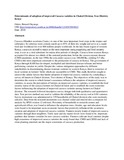| dc.description.abstract | Cassava (Manihot esculenta Crantz,) is one of the most important food crops in the tropics and subtropics. Its tuberous roots contain starch up to 85% of their dry weight and serve as a staple food and livelihood for over 800 million people worldwide. In the lake basin region of western Kenya, cassava is second to maize as the most important energysupplying and food security crop; it acts as a vital substitute for maize after periods of drought. Cassava from western Kenya accounted for almost two-thirds of the national production, before the cassava mosaic disease (CMD) pandemic, in the late 1990s the area under cassava was 100,000 ha, yielding 9.5 t/ha. CMD.is the most important constraint to the production of cassava in Kenya.
The government of Kenya through KARl has developed, multiplied and distributed disease tolerant and better performing varieties in yields. Despite the various mitigation approaches by different stakeholders in disseminating disease resistant varieties in western Kenya, there is existence of local varieties in farmers' fields which are susceptible to CMD. This study therefore sought to unravel the salient factors that hinder adoption of improved cassava varieties by conducting a survey of famers in Chakol division, Teso district of Kenya. The objectives of the study was to determine the extent to which farmer's awareness influence the adoption of improved cassava varieties, to assess the perception of farmers on improved cassava varieties, to establish the food security status of the cassava farmers in Chakol division and to establish the socio economic factors influencing the adoption of improved cassava varieties among farmers in Chakol division. The research followed descriptive survey design with both qualitative and quantitative data.
Test pre test method was used to validate the reliability of the survey tool at 0.84 variance. Survey instrument was administered to 359 households of Chakol division who were randomly selected. Data from the research instrument was cleaned coded and entered into a computer for analysis by SPSS version 12 software. Proximity of households to research centers and agricultural offices was found to influence the adoption rates. Gender, age and education levels were found to be important socio-economic factors that positively influenced the awareness creation and adoption of improved cassava varieties. Farmers mostly learnt of improved cassava varieties through their neighbors. Yield, taste and dry matter levels were found to be. important qualities that farmers consider for new cassava varieties. Farmers cultivate local varieties despite high awareness of improved cassava varieties the study found that. CMD and CBSD and lack of clean planting materials are the major constraints of cassava production. | en_US |

